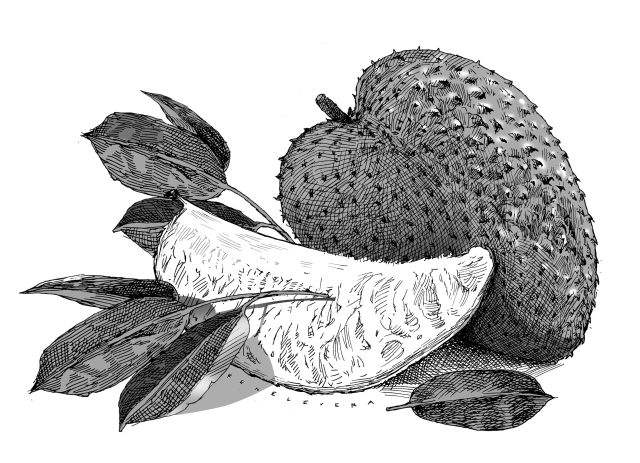
When a friend posted a photograph of the first fruit of her guyabano tree, I wasted no time to ask her what she did to produce it, especially as her tree did not seem to have put on years. We have several of these trees around the house, most of them approaching a decade in age, and I still have to see a fruit on them. Not too long ago, however, one delighted us with a little green spiky fruit. But on the way to ripeness, it fell off its stem, a victim of aphids or harsh weather (in my frustration, I did not bother to find out which).
After that our trees just kept on putting out leaves without ever doing us the courtesy of a solitary flower. I asked around about procedures to induce them to bear fruit. The suggestions that I got—supposedly set by tradition—required the hammering of three nails into the trunk, or the hacking of it for three times. The triad I understand, having read a bit of German philosophy, but, despite my familiarity with the history of religions, I cannot grasp the nails and the hack wounds. The one who told me about the techniques gave no explanation, either religious or philosophical. I surmised that the nailing and the hacking, and behind them the threat of a worse injury, would scare the tree into yielding fruit.
I tried these methods on our trees. It worked with the jackfruit, but not with the guyabano and avocado, which must consider it its mission to just grow and not fructify–it now towers over our house, running the risk of literally getting the axe in the event of a severe weather warning. Although, in my impatience, I can give it the same axe on a fine day, I will not do so, remembering Aristotle’s words, “Patience is bitter, but its fruit is sweet.”
One day, my patience was rewarded with a different kind of fruit. As I walked behind the house, and passed beside the avocado tree, a little feather drifted down. When I looked up to where it came from, I saw a nest, hanging from a branch towards the top of the tree. It looked empty, which I confirmed for myself when a breeze detached it from the branch, and, as it hit the ground, it broke up into its components–grass, leaves, feathers, which a bird had woven into a little bag for her chicks, and which when it was time the brood abandoned.
The nest called up what Jesus said on a journey to Jerusalem. Luke writes that someone had told the Lord, “I will follow you wherever you go.” And Jesus answered, “Foxes have dens and birds of the sky have nests, but the Son of Man has nowhere to rest his head.” Obviously, he wanted to warn the man about the demands of discipleship, that it asked the follower to be single-minded in his purpose, no matter if this deprived him of a home.
One afternoon, while taking a walk, I saw hanging from nails on a concrete wall a cloth hammock, the kind in which poor mothers put their infants to sleep. Whoever fixed it there–likely as not a homeless woman–could not have found a more strategic place for her baby–there it could sleep while she went about her tasks. Only the rain could have upset the setup, but the sky showed no hint of it beyond the feathery clouds.
Incidentally, I found the day prepared for a bit of joyful surrealism–the concrete wall bearing fruit, a white hammock, which for the nonce had become an empty nest–mother and child having left, momentarily, since, no matter how humble a possession the hammock was, they had need of and would return for it.
In my case, I return to the guyabano and avocado trees daily, as though expecting a gift, a surprise, no matter if, instead of a fruit, I might find an abandoned nest–a message of man’s self-imposed homelessness, a reminder that since we have drained this life of its mystery, as Rainer Maria Rilke puts it, “we are not really at home in our interpreted world.”